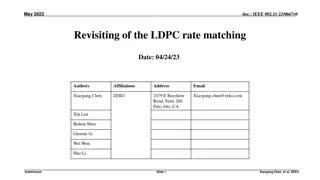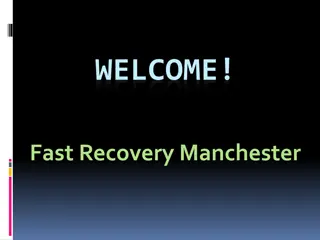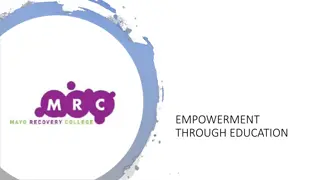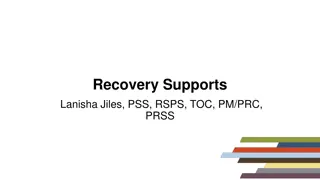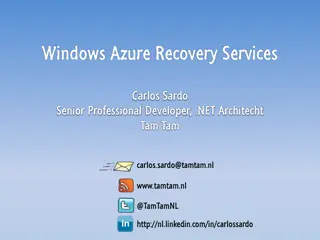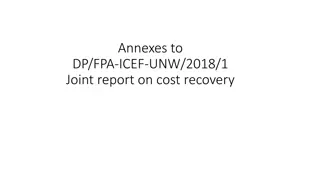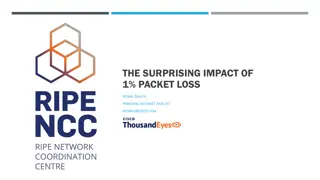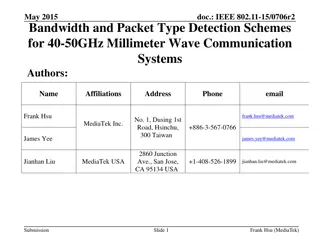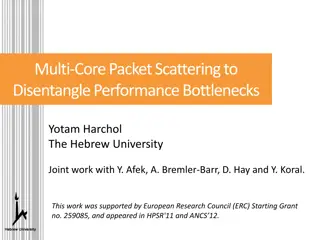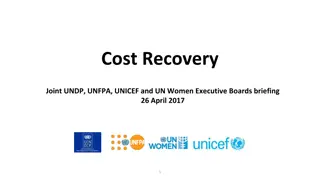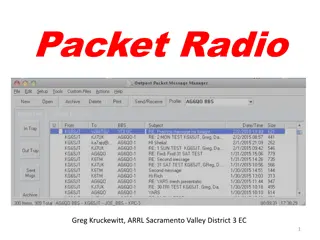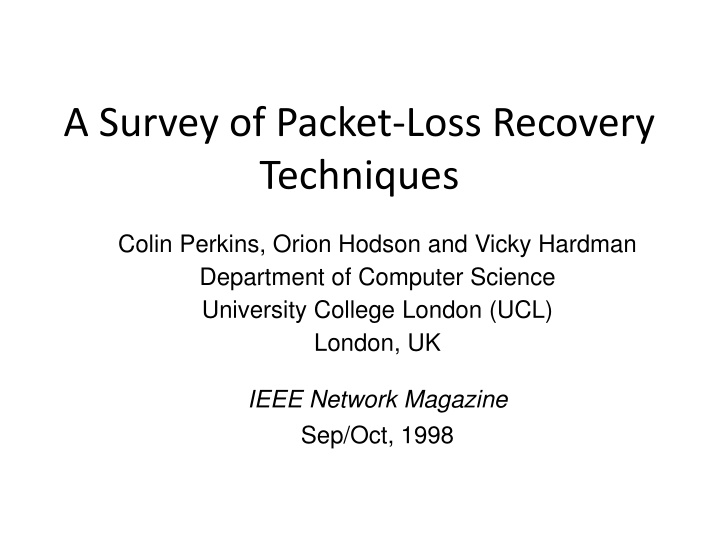
Survey of Packet-Loss Recovery Techniques
This paper provides a detailed overview of the development of IP multicast, focusing on handling packet loss and repair techniques beyond retransmission. It discusses loss characteristics of Mbone, repair methods, multicast channel characteristics, sender-based and receiver-based repair, and recommendations for reliable real-time communication.
Download Presentation

Please find below an Image/Link to download the presentation.
The content on the website is provided AS IS for your information and personal use only. It may not be sold, licensed, or shared on other websites without obtaining consent from the author. If you encounter any issues during the download, it is possible that the publisher has removed the file from their server.
You are allowed to download the files provided on this website for personal or commercial use, subject to the condition that they are used lawfully. All files are the property of their respective owners.
The content on the website is provided AS IS for your information and personal use only. It may not be sold, licensed, or shared on other websites without obtaining consent from the author.
E N D
Presentation Transcript
A Survey of Packet-Loss Recovery Techniques Colin Perkins, Orion Hodson and Vicky Hardman Department of Computer Science University College London (UCL) London, UK IEEE Network Magazine Sep/Oct, 1998
Overview Development of IP Multicast Light-weight session Scale to 1000 s of participants How to handle packet loss? (MLC: why doesn t retransmission work?) Repair techniques beyond retransmission
Overview This paper: Loss characteristics of Mbone (MLC dated, but not dissimilar from some P2P networks and ad-hoc wireless networks) Techniques to repair loss in a light-weight manner Concentrate on audio Recommendations Other papers: Fully-reliable (every bit must arrive), but not real-time Real-time, but do not include receiver based approaches
Outline Overview Multicast Channel Characteristics Sender Based Repair Receiver Based Repair Recommendations
IP Multicast Channel Characteristics Group address Client receives on address Sender sends to address, without knowledge of clients Loosely coupled connections Extension to UDP Not two-way Makes it scalable Allows clients to do local repair Multicast router shares with unicast traffic Can have high loss Often MBone router 2nd rate
MBone Loss Characteristics Some receivers near 0% loss rates Most receivers in the 2-5% loss range Some see 20-50% loss Characteristics differ, so need local decisions
Mbone Jitter Characteristics High jitter If too late, will be discarded and look like loss (e.g. I-policy) Interactive applications need low latency Influences repair scheme
Media Repair Taxonomy Media Repair Sender Based Receiver Based
Sender Based Repair Taxonomy Work from right to left Unit of audio data vs. a packet Unit may be composed of several packets Or one packet may have several units of audio data
Forward Error Correction (FEC) Add extra data to stream Use extra data to recover lost packets Two classes: Media independent (not multimedia specific) Media dependent (knowledge of audio or video)
Media Independent FEC Given k data packets Generate n-k check packets Transmit n packets Schemes originally for bits (like checksums in packet headers) Applied to packets So, for example i th bit of check packet, checks i th bit of each associated packet
FEC Coding e.g., XOR operation across all packets Transmit 1 parity packet every n data packets If 1 loss in n packets, can fully recover e.g., Reed-Solomon treat as polynomial, add k packets redundancy If k-1 loss in n packets, can fully recover
Media Independent FEC Advantages and Disadvantages Advantages Media independent Audio, video, different compression schemes Computation is small and easy to implement Disadvantages Add delay (must wait for all n packets) Add to bitrate (causing more loss?) Add decoder complexity
Media Specific FEC Multiple copies of data Quality of secondary frames?
Media Specific FEC Secondary Frame Send packet energy and zero crossing rate 2 numbers, so small Coarse, but effective for small loss Better than interpolating across missing packets Low bit-rate encoded version of primary Lower number of sample bits audio sample, say Full-version of secondary Effective if primary is small (low bandwidth)
Media Specific FEC Discussion Typical overhead 20-30% for low-quality Media specific FEC can repair various amounts by trading off quality of repair Contrast with media independent FEC has fixed number of bits for certain amount of full repair Can have adaptive FEC When speech changes and cannot interpolate Add when increase in loss Delay more than 1 packet when bursty loss
Media Specific FEC Advantages and Disadvantages Advantages Low latency Only wait for one additional packet to repair Or multiple if adapted to bursty losses Can have less bandwidth than independent FEC Disadvantages Computation may be more difficult to implement Still adds to bitrate Adds decoder complexity Typically lower quality (vs. other methods of repair)
Interleaving Doesn t really repair, rather mitigates effects of loss Many audio tools send 1 phoneme (40 ms of sound), so most of phoneme intact
Interleaving Advantages and Disadvantages Advantages Most audio compression schemes can do interleaving without additional complexity No extra bitrate added Disadvantages Delay of interleaving factor in packets Even when not repairing! Gains to quality can be modest
Retransmission If delays less than 250 ms, can do retransmission Effective for LAN or fast Internet connection But wide-area wireless & inter-continetnal connection can be 200ms + Scalable Reliable Multicast (SRM) Hosts time-out based on distance from sender To avoid implosion Mcast repair request (and repair) to all All hosts can reply (timers based on distance stop implosion)
Retransmission Discussion In typical multicast session, can have every packet usually lost by some receiver Will always retransmit at least once FEC may save bandwidth Typically, crossover point to FEC based on loss rate Some participants may not be interactive Use retransmission Others use FEC
Retransmission Advantages and Disadvantages Advantages Well understood Only add additional data as needed Disadvantages Potentially large delay Not usually suitable for interactive applications Large jitter (different for different receivers) Implosion (setting timers difficult)
Media Repair Taxonomy Media Repair Sender Based Receiver Based Do not require assistance of Sender Receiver recovers as best it can Often called Error Concealment Can work well for small loss ( up to 15%), small packets (4-40 ms) Not substitute for sender-based Rather use both Receiver based can conceal what is left
Taxonomy of Error Concealment When packet is lost, replace with fill-in
Splicing Splice together stream on either side Do not preserve timing Advantages Easy Works ok for short packets of 4-16 ms Disadvantages Poor quality for losses above 3% Can interfere with delay buffering
Silence Substitution Fill gap left by lost packet with silence Preserve timing Advantages Still Easy Works well for low loss (< 2%) Works ok for short packets of 4-16 ms Disadvantages Poor quality for higher losses (3%+) Ineffective with 40 ms packets (typical)
Noise Substitution Human psych says can repair if sound, not silence (phonemic restoration) Replace lost packet with white noise Like static on radio Still preserve timing Similar to silence substitution Sender can send comfort noise so receiver gets white-noise volume right
Repetition Replace missing packet with previous packet Can fade if multiple repeats over time Decrease signal amplitude to 0 Still pretty easy, but can work better than nothing A step towards interpolation techniques (next)
Noise Substitution and Repetition Advantages Easy to implement Works well for small loss (up to 5%) Disadvantages Still doesn t work well for larger losses Does not work well for larger packets
Taxonomy of Error Concealment When packet is lost, reproduce packet based on surrounding packets.
Interpolation Based Repair Waveform substitution Use waveform repetition from both sides of loss Works better than repetition (that uses one side) Pitch waveform replication Use repetition during unvoiced speech and use additional pitch length during voiced speech Performs marginally better than waveform Time scale modifications Stretch audio signal across gap Generate new waveform that smoothly blends across loss Computationally heavier, but performs marginally better than others
Original Loss Wave Substitution (Boundaries better) Repetition (Both bad at C)
Taxonomy of Error Concealment Use knowledge of audio compression to derive codec parameters, using knowledge of code to regenerate
Regeneration Based Repair Interpolation of transmitted state State-based decoding can then interpret what state codec should be in Reduces boundary-effects Typically high processing Model-Based recovery Regenerate speech to fit with speech on either side Very complicated, often language dependent
Summary of Receiver Based Repair Knee Quality increase decreases at high complexity Repetition is at knee in curve
Groupwork Consider: Interactive voice from Asia to U.S. Multicast video of taped lecture Multicast replicated database update Interactive voice across city Choose a repair technique and justify: Interleaving Retransmission Media Specific FEC Media Independent FEC
Recommendations: Non-Interactive Applications Latency less important Bitrate a concern (mcast has varied capacities) Can use interleaving Use repetition for concealment Retransmission does not scale Ok for unicast Media independent FEC may be ok
Recommendations: Interactive Applications Want to minimize delay Interleaving delay is too large Retransmission delay can be large Media independentFEC usually large (Or computationally expensive) Can use media specific FEC Delay is low Approximate repair is ok Can be tuned (via quality and repair placement) to suit network and user

